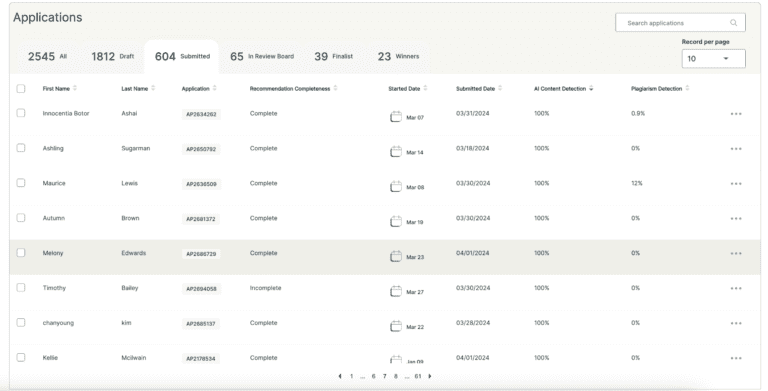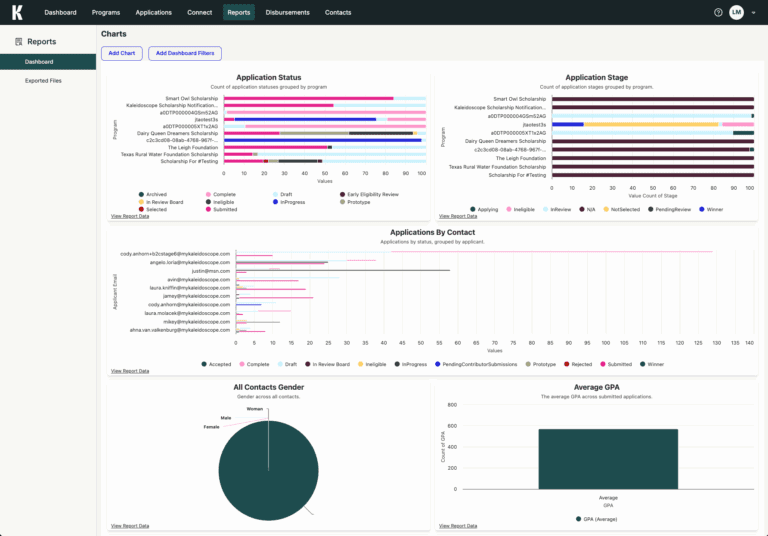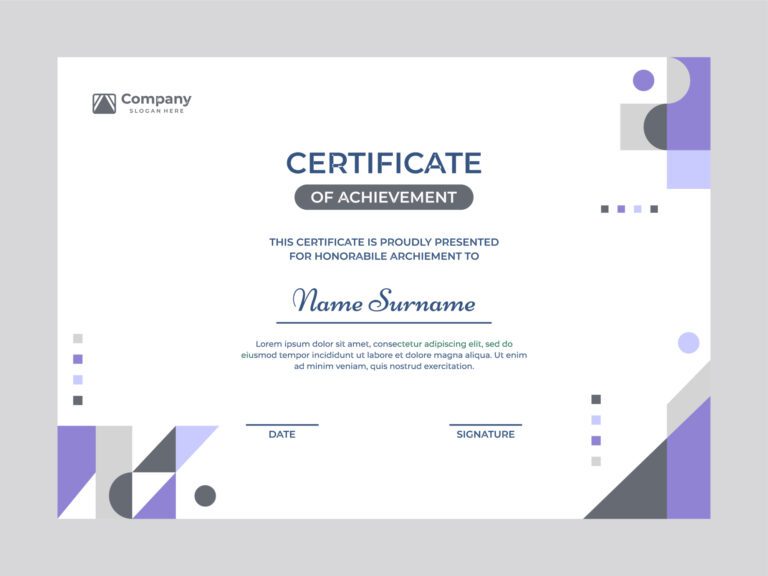The landscape of scholarship management is evolving rapidly, driven by technological advancements, social change, and increasing expectations for transparency and efficiency. To stay competitive and impactful, scholarship providers must understand and adapt to these trends. Here, we explore the top scholarship management trends shaping 2025 and how they can transform your program.
1. AI and Automation in Scholarship Processes
Artificial intelligence (AI) and automation are revolutionizing scholarship management. From helping write application questions to detecting plagiarism, AI reduces administrative workloads while ensuring fairness and consistency.
- Use Case: Automating with tools such as Kaleidoscope’s AI & Plagiarism detection can save countless hours and enhance decision-making accuracy.
As of 2024, 58% of nonprofits have incorporated AI into their communications, and 68% use it for data analysis. Source
- Tip: When adopting AI, ensure ethical use by avoiding bias in data when prompting and maintaining transparency on usage with applicants.
For additional ways to use AI tools in your program, check out our AI guide here.

2. Building Deeper Scholar Relationships
A scholarship isn’t just a check; it’s the start of a relationship. In 2025, more providers are prioritizing long-term engagement with scholars through Scholar Relationship Management (SRM) platforms.
Why It Matters: SRM tools allow programs to track communications, milestones, and outcomes across the scholar lifecycle, turning one-time awards into ongoing investments.
“We’ve built trust and created strong networks. Now we have the opportunity to strategically align relationships across sectors.”
— Jill Marecki & Erin Talbot, Detroit Regional Dollars for Scholars (Source)
Action Step: Implement an SRM platform to deepen your connection with scholars and track long-term outcomes.

3. Increased Focus on Diversity, Equity, and Inclusion (DEI)
Scholarship programs are increasingly designed to address barriers faced by underrepresented groups. DEI initiatives are not just ethical but also essential for creating equitable opportunities. However, the U.S. Department of Education recently cut over $600 million in grants to institutions and nonprofits, affecting programs that supported DEI education. Source
- Implication: DEI programs are going to receive less investment from the government; private entities will need to continue to invest to support these programs.
- Tip: With reduced federal funding, private organizations should consider the following to ensure continued support for underrepresented groups.
- Reviewing and potentially modifying DEI programs to align with new federal guidelines while maintaining a commitment to equity.
- Exploring alternative funding sources, including increased partnerships with private sector entities and foundations.
- Collaborating with other nonprofits to navigate these changes and advocate for the importance of DEI work in creating a more just and equitable society.
4. Rise of Video and Creative Applications
Traditional essay formats are giving way to video and multimedia submissions, allowing applicants to express themselves more creatively. This creative approach adds a new dimension to scholarship management.
- Why It Matters: Videos provide a richer understanding of an applicant’s personality, goals, and potential. They are more effective than writing because they allow viewers to observe body language, verbal tone, and visual cues, leading to better message retention; viewers retain 95% of a video’s message, compared to only 10% when reading text. Source.
Action Step: Incorporate video uploads into your application process using platforms like Kaleidoscope, which makes this seamless. You can replace long-written essays with a video submission requiring applicants to create a creative, telling story highlighting their uniqueness. Incorporating a video at least once in your application process can help reviewers better understand the applicant, eliminate bias in writing, and give more opportunities to underserved students who may not have writing support.

5. Data-Driven Decision Making
In an era of limited resources and rising expectations, data is everything. Leading programs are investing in real-time dashboards that let them evaluate application funnels, demographic reach, and post-award impact at a glance.
- Benefit: Insights can help refine selection criteria and improve program outreach. Dashboards provide actionable insights, helping you make faster, smarter decisions and improve ROI.
“Scholarship providers should invest in the tools program leaders need to proactively advise students… These tools leverage data analytics and provide alerts at the first sign of student struggle.”
— Natalie Grandison, Director of Engineering Initiatives, A. James & Alice B. Clark Foundation (Source)
Tip: Use platforms with built-in analytics and customizable dashboards to continuously evaluate and improve your program.

6. Demand for Transparency and Ethical Standards
Applicants and stakeholders increasingly value transparency in how scholarships are awarded. Clear criteria and ethical practices build trust and credibility. Transparency is a significant component of effective scholarship management.
- Best Practice: Publicly share your selection process and criteria to reassure applicants of fairness. You can do this by publishing a page on your website that clarifies the criteria, or even posting a link to the scoring rubric directly on your application page. Clear and accessible scholarship guidelines enable students to assess their eligibility, reducing irrelevant applications and simplifying the review process. Centralizing all scholarship information in one location, such as a landing page, also enhances discoverability and clarity, while consistent guideline updates ensure accuracy and prevent applicant confusion.
- Tip: Leverage platforms such as Kaleidoscope with built-in features for blind reviews and unbiased scoring.
7. Integration of Corporate Social Responsibility (CSR)
For companies offering scholarships, aligning programs with CSR goals enhances both community impact and brand reputation.
- Example: A renewable energy company creating scholarships for students in environmental studies.
- Action Step: Design your scholarship to reflect your organization’s mission and values. Scholarships can help boost corporate brand loyalty, trust, and employee retention, and motivate consumers to switch to their brand.
8. Increased Collaboration Between Organizations
Collaborative scholarship programs are gaining popularity. Partnerships between nonprofits, corporations, and educational institutions amplify reach and resources.
- Example: Co-branded scholarships funded by multiple organizations to support a shared cause.
- Tip: Seek partnerships that align with your goals to maximize impact. The right partner can help expand your program’s reach, increase funding sources, unlock more dollars for scholars, and make a greater impact.
9. Blockchain and Digital Credentials
Blockchain technology is emerging as a secure way to verify applications and track scholarship funds. Digital credentials also offer long-term benefits for recipients and are becoming a key element in scholarship management.
- Advantage: Blockchain can ensure the integrity of application data and payment transparency. The streamlined nature of blockchain platforms can enable immediate disbursements and offer reduced administrative costs for institutions.
- Future Outlook: Explore digital credentials to give recipients portable, verifiable recognition of their awards.

How to Adapt Your Program
To stay ahead in 2025, consider these steps:
- Invest in Technology: Adopt tools like SRM systems, real-time dashboards, and AI-supported workflows.
- Promote Inclusivity: Reevaluate your eligibility criteria to match evolving student demographics.
- Increase Transparency: Share your selection criteria publicly and review tools for fairness.
- Build Partnerships: Collaborate across sectors to expand support and funding.
- Think Beyond the Award: Consider career development, transportation, mentorship, and other services that support students holistically.
Conclusion
Scholarship providers in 2025 are no longer just funding college; they’re building ecosystems of support, trust, and transformation. By embracing technology, SRM, data-driven insights, and equity-focused design, providers can not only adapt to the trends but also lead them.
Ready to elevate your scholarship program? Explore how Kaleidoscope’s innovative platform can help you implement these trends and stay ahead of the curve. Learn More.











